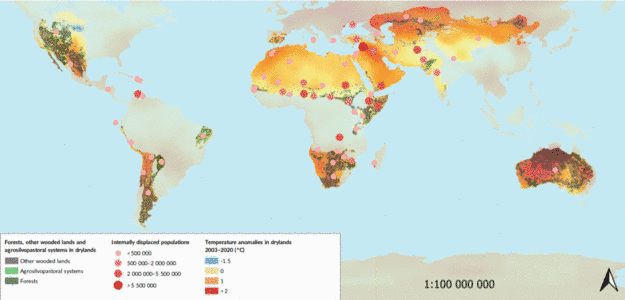Deploying a humanitarian-development-peace nexus approach
Exploring, strengthening and reviving dryland ecosystems
Drylands are currently home to about 25 percent of the global population, contain 50 percent of the world’s livestock, 27 percent of the world’s forests(FAO, 2019), store 30 percent of the world’s soil organic carbon, and supply about 60 percent of the world’s food production (IUCN.2008). However, as important as drylands are for food security and mitigating climate change, they are also characterized by variable precipitation, climate variability and water scarcity. The effects of climate change are exacerbating these conditions with longer periods of drought, accelerated desertification, and causing impacts on biodiversity and vegetation cover that reduce soil fertility – all of which undermine food and nutrition security. Population growth coupled with expansion of drylands due to climate change could increase the number of people living in challenging conditions by up to 70 percent by 2030 (World Bank, 2017). Therefore, climate change can act as a conflict threat multiplier, whereby already fragile ecosystems and local communities are pushed beyond coping capacity, resulting in increasing tensions related to natural resource access and use (IPCC, 2019). Key vulnerable groups in dryland ecosystems include pastoralists and agro-pastoralist households, as well as internally displaced persons, refugees and migrants resulting from the impacts of climate change and conflict, with women and children particularly at risk.
The interconnected nature of temperature anomalies and internal displacement of populations in dryland forests and other wooded lands and associated agrosilvopastoral areas.
Insights on the ground: Learning from case studies
Insights on the ground: Learning from case studies
Given the importance of dryland ecosystems, the growing impacts of climate change and conflict in these regions, as well as the renewed focus on facilitating long-term landscape restoration. FAO, CGIAR, and CARE gathered 18 cases in contexts that confront the multidimensional nature of climate- and conflict-related impacts in drylands to shed light on elements that support an HDP nexus approach so as to minimise the conflict threat multiplier of climate change in dryland ecosystems where conflict is possible, present, or latent.
Lessons emerging from the case studies can be classified across four key themes, which are useful for decision-makers to consider in delivering long-term effective solutions. All the themes are interlinked and are essential in any humanitarian or development context. However, our analysis focuses on why these themes are particularly crucial to address in conflict situations in dryland ecosystems. These themes are:
- Inclusion: Adapt interventions to the specific needs and interests of the most vulnerable [e.g. internally displaced persons (IDPs), women, indigenous people, youth] and meaningfully involve them in governance processes and structures
- Conflict sensitivity: Integrate conflict sensitivity approaches (based on context/conflict analysis) to avoid exacerbating or creating conflict
- Climate/food security: Integrate climate change adaptation and food and nutrition security measures towards ensuring environmental sustainability and overall human security
- Monitoring: monitor climate change to reduce and plan ahead for its related impacts.


